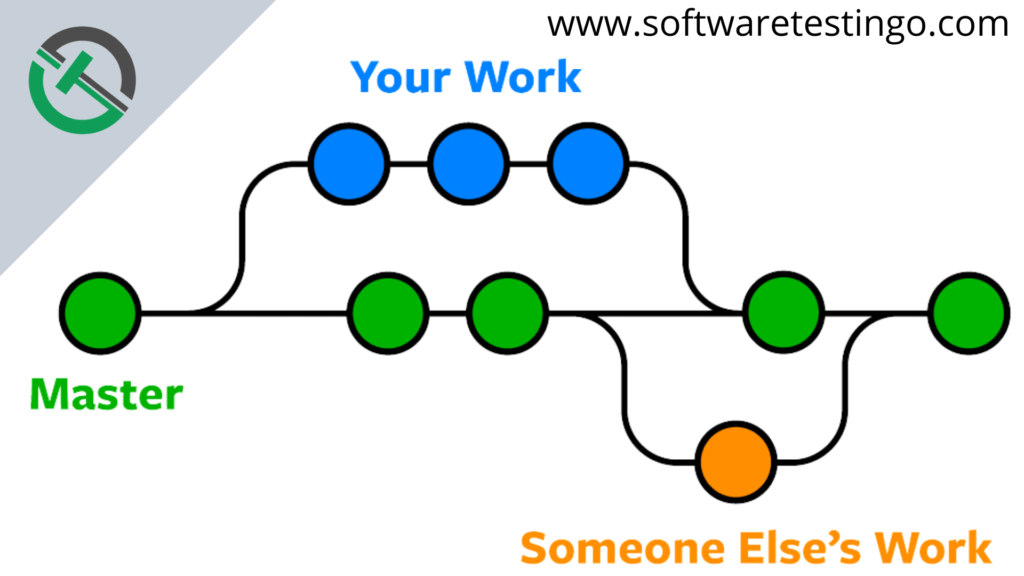Git is a development tool used to manage different versions (or branches) of code for an application. It’s very popular and used by many high-profile projects. Git is also quite efficient. One of the key features of Git is its ability to help manage and improve the creation process for a project by controlling various versions (or branches) of code development.
This tutorial will show you how to use Git branches. Using branches in Git helps us keep multiple versions of an application organized. Therefore, it is very important to know how to work with them. After completing this tutorial, your understanding of Git should be improved overall.
| Post Type: | GIT Tutorial |
| Published On: | www.softwaretestingo.com |
| Applicable For: | Freshers & Experience |
| Get Updates: | Join Our Telegram Group |
What is a Git Branch?
In Git, a branch is like the branch of a tree. Just as a tree branch is attached to the central part of the tree (the trunk), branches in Git are attached to the main project (called the “master”). While branches can be created and deleted, the trunk remains intact similarly; in Git, Branches can be generated and deleted, but the master remains unchanged.
Creating branches in Git helps keep the main project development separate from new features or modifications. This way, coding for a new feature or modification does not affect the primary project codebase. In other words, branches create another line of development in the project.
Note: The primary or default branch in Git is the master branch.
Why do we need a Branch in Git, and Why are branches important?
If you’re working on a project and need to create a new branch, there are many advantages to doing so. Branches create another line of development that is entirely different or isolated from the main stable master branch, which can come in handy at many different points during the development process.
Let us take an example to understand how Git branches are helpful. If you need to work on a new feature for a website, you can create a new branch. If you get a request to make a change that needs to go live today, you can switch back to the master branch and push it live. Then, you can switch back to your new feature branch and finish your work. When you’re done, merge the new feature branch into the master branch, keeping both changes!

There are multiple advantages to using Git Branches. The following two are the most important:
- You can develop new features for your application without affecting the development process in the main branch.
- Git branches are a great way to manage different development versions of your code base. You can create separate branches for things like stability testing, new features, and bug fixes. This lets you easily merge changes from one branch into another as needed.
There are many different ways developers can create software, and each method has its advantages. With enough experience, you’ll be able to figure out which methods work best for you.
Different Operations On Branches
Everything will involve branches from the time of creating the repository until its deletion. So, this is a concept to remember and analyze carefully.
In this tutorial, we’ll discuss the definition and importance of branches. This complete section on branches will take you through some operations and concepts that can help you use Git more efficiently. So let us See the different operations on Git Branches like:
- Create a Git Branch: This is the first step of many in the process. It’s best to begin on a default branch if you’re just getting started. You can always create a new branch later for development if needed.
- Merge A Git Branch: You can merge a branch with any other branch in your Git repository at any time. Merging a branch is especially helpful when you’re done working on the branch and want to integrate its code into another branch.
- Delete A Git Branch: If you have a branch that is no longer needed, you can delete it from your Git repository. This can be helpful when the branch has already been merged or if there is any other reason why you don’t need it anymore.
- Checkout A Git Branch: If you’re already working on a branch and want to create a clone so you can work on any of them, simply pull or checkout the branch. This is especially useful if you don’t want to disturb the older branch but want to experiment with the new one.
We hope you understand the importance of branches now. If you’re still unsure about how to create them or what goes on behind the scenes, don’t worry! We’ll explain all that in our next tutorial. For now, hopefully, you have a better idea of why branches are such an important part of Git.
